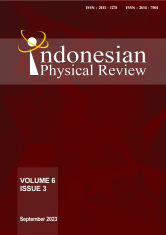PHYSICOCHEMICAL PROPERTIES ANALYSIS OF LOCAL CERAMICS WITH ACTIVATED CARBON ADDITIVE BASED ON RUBBER FRUIT SHELLS AS THERMAL INSULATORS
DOI:
10.29303/ipr.v6i3.232Downloads
Abstract
Many building materials that function as insulators to maintain indoor temperature stability during hot weather have been developed. One of them is porous ceramics applied to building walls as heat absorbers. Research related to the manufacture of porous ceramics began to emerge to find the optimal composition when applied as an insulator that can absorb heat well. In general, porous ceramics use activated carbon as a pore agent. Activated carbon can be obtained by carbonating agricultural wastes such as coconut shells, hazelnut shells, rubber fruit shells, rice husks, and cocoa shells. Research continues to develop in finding the best-activated carbon base material according to the required material characteristics. Researchers will take advantage of the abundant potential of local natural resources. The method used to make porous ceramics is to mix clay and activated carbon with a clay-carbon composition ratio of 100:0, 90:10, 80:20, 70:30, 60:40, and 50:50. The sample is made by mixing the two materials and then printed by dry pressing method with a load of 5 tons held for 10 minutes. After the sample is dried at room temperature, it is sintered at 900oC with a holding time of 3 hours. Next, the sample is characterized by determining density, porosity, and water absorption and then tested for thermal properties. After that, the surface morphology and elements in the sample are seen. The optimum composition of clay-carbon mixture is 70:30 grams. Ceramics using activated carbon from rubber fruit shells are suitable as building construction materials as heat insulators because they can absorb heat up to 500oC.Keywords:
Insulator; Porous Ceramic; Rubber Fruit Shells, Clay; Activated CarbonReferences
A. Mas’at, “Efek Pengembangan Perkotaan Terhadap Kenaikan Suhu Udara Di Wilayah DKI Jakarta,†Agromet, vol. 23, no. 1, pp. 52–60, 2009.
S. Anambyah and E. Setyowati, “Pengaruh Pewarnaan Beton Cetak pada Dinding Serap,†Forum Teknik., vol. 33, pp. 61–67, 2010.
R. Zainul, Kimia Material. Padang: CV Berkah Prima, 2021.
Nofirman, “Interpretasi Satuan Litologi, Satuan Bentuk Lahan, dan Struktur Geologi dengan Integrasi Citra SRTM Di Wilayah Kota Bengkulu,†Jurnal Geografflesia., Vol. 1, No. 2, p. 27-37, 2016.
M. Kurniawan, A. S. Budi, and A. B. Susilo, “Pembuatan Membran Keramik Berpori Berbasis Clay Dengan Variasi Zeolit Dan Penambahan Arang Aktif Tempurung Kelapa Serta Polivinyl Alcohol,†in Prosiding Seminar Nasional Fisika UNJ, 2014, pp. 279–282.
Sisnayati, R. Komala, and R. Suryani, “Pengaruh Komposisi Aditif Sekam Padi Terhadap Ukuran Pori, Luas Permukaan dan Porositas Membran Keramik,†Jurnal Teknik Kimia., vol. 24, no. 3, pp. 51–56, 2018.
S. Sulistyo, “Dampak Proses Sintering Material Keramik pada Sifat Mekanik dan Dimensi Suatu Produk,†Rotasi, vol. 20, no. 4, p. 244, 2018, doi: 10.14710/rotasi.20.4.244-248.
A. N. Mahfuzin, S. M. B. Respati, and D. Muhammad, “Analisis Filter Keramik Berpori Berbasis Zeolit Alam dan Arang Sekam Padi dalam Menurunkan Kandungan Partikel Air Sumur Galian,†Momentum, vol. 16, no. 1, pp. 63–68, 2020.
C. Banon, T. D. Sutanto, I. Gustian, I. Koharudin, and W. Rahmi, “Cangkang Buah Karet Dengan Perekat Limbah Plastik Polipropilena Sebagai Alternatif Papan Partikel,†Jurnal Kimia Riset., vol. 1, no. 2, pp. 86–93, 2016, doi: 10.20473/jkr.v1i2.3091.
T. Hidayat, “Pembuatan Keramik Berpori Dari Tanah Liat Dan Serbuk Tembaga (Cu) Dengan Menggunakan Serbuk Batang Kelapa Sawit Sebagai Agen Pembentuk Pori Untuk Filter Pada Gas Buang Kendaraan Bermotor,†Thesis., Universitas Sumatera Utara, 2019.
G. Klancnik, J. Medved, and P. Mrvar, “Differential thermal analysis ( DTA ) and differential scanning calorimetry ( DSC ) as a method of material investigation,†Materials and Geoenvironment, vol. 57, no. 1, pp. 127–142, 2010.
T. D. Tambunan, “Pembuatan Keramik Berpori Sebagai Filter Gas Buang Dengan Aditif Karbon Aktif,†Thesis., Universitas Sumatera Utara, 2008.
F. Anisah, “Pembuatan Keramik Berpori Berbasis Clay dengan Aditif Karbon Aktif Cangkang Kemiri,†Thesis., Universitas Sumatera Utara, 2019.
Abdillah, G. Saragih, M. Z. Akbari, and V. Purwandari, “Pembuatan Penyerap Gas Buang Kendaraan Bermotor Berbasis Limbah Padat Kelapa Sawit,†Jurnal Kimia Saintek dan Pendidikan., vol. 7, no. 1, pp. 21–26, 2023, doi: https://doi.org/10.51544/kimia.v7i1.3904.
A. Elgamouz and N. Tijani, “From a naturally occurring-clay mineral to the production of porous ceramic membranes,†Microporous Mesoporous Mater., vol. 271, no. May, pp. 52–58, 2018, doi: 10.1016/j.micromeso.2018.05.030.
License

This work is licensed under a Creative Commons Attribution-NonCommercial-ShareAlike 4.0 International License.
Authors who publish with Indonesian Physical Review Journal, agree to the following terms:
- Authors retain copyright and grant the journal right of first publication with the work simultaneously licensed under a Creative Commons Attribution-ShareAlike 4.0 International Licence (CC BY SA-4.0). This license allows authors to use all articles, data sets, graphics, and appendices in data mining applications, search engines, web sites, blogs, and other platforms by providing an appropriate reference. The journal allows the author(s) to hold the copyright without restrictions and will retain publishing rights without restrictions.
- Authors are able to enter into separate, additional contractual arrangements for the non-exclusive distribution of the journal's published version of the work (e.g., post it to an institutional repository or publish it in a book), with an acknowledgment of its initial publication in Indonesian Physical Review Journal.
- Authors are permitted and encouraged to post their work online (e.g., in institutional repositories or on their website) prior to and during the submission process, as it can lead to productive exchanges, as well as earlier and greater citation of published work (See The Effect of Open Access).





